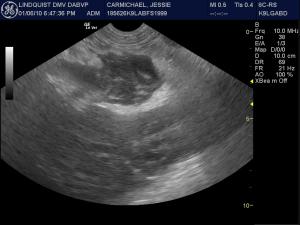Clinical Differential Diagnosis
(Remo Lobetti PhD, DECVIM):
Pancreas – pancreatitis, pancreatic neoplasia
GI tract – obstruction, neoplasia, intestinal perforation, infectious (viral, bacterial)
Sonographic Differential Diagnosis
(Lindquist DMV, DABVP): Pancreatitis with probable necrosis and sequestered tissue. Chronic active inflammation is likely given the mixed echogenicity of the tissue with irregular hyperechoic intrapancreatic changes suggestive for fibrosis and potential mineralization. Pancreatic neoplasia such as carcinoma cannot be ruled out and potentially suspected given signs of early mineralization (hyperechoic foci). The position of the pathology in the right limb and approaching the pancreatic base would predispose the patient to extra-hepatic common bile duct obstruction should bilirubin values begin to elevate.
Sampling
(Lindquist DVM DABVP): Cytology of fine-needle aspirates were performed and revealed active hemorrhagic pancreatitis. Biopsy of the pancreas revealed moderate, acute, suppurative, necrotizing pancreatitis.
Outcome
(Messina DVM, Madison AH Madison, NJ): The patient responded well to hospitalization and aggressive treatment for pancreatitis with pain management, plasma expansion, antibiotics and GI protectants. The patient was clinically normal at a 1-week follow-up. The amylase and lipase values normalized at a 14-day follow-up and the patient was clinically normal. 11 weeks later the patient presented with weakness and clinical signs consistent with pancreatitis/sepsis with elevated bilirubin values. The owners elected humane euthanasia at that point owing to poor quality of life from orthopedic and suspected recurrent pancreatic disease.



Comments